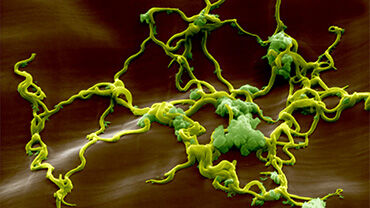A population model to describe the distribution and seasonal dynamics of the tick hyalomma marginatum in the Mediterranean basinArchived
A dynamic population model of Hyalomma marginatum, the vector of several pathogens in the western Palearctic, was developed to simulate effects of temperature and water vapour deficit (VD) on tick survival, development rates and seasonality.
Estrada-Peña A (1), Martínez Avilés M (2), Muñoz Reoyo MJ (2) Transboundary and Emerging Diseases 2011 Jan 12; doi: 10.1111/j.1865-1682.2010.01198.x. [Epub ahead of print]A dynamic population model of Hyalomma marginatum, the vector of several pathogens in the western Palearctic, was developed to simulate effects of temperature and water vapour deficit (VD) on tick survival, development rates and seasonality. Base tick survival and development rates were obtained from laboratory-controlled experiments or calculated from reported data. These rates were modelled as temperature-dependant time delays or accumulated mortality by temperature and water VD stress. Using daily data derived from a gridded data set at 10-min resolution, the model reached stable and cyclical equilibria in an area that corresponds largely with the reported distribution of the tick in western Palearctic. The model did not identify a potential range of suitable climate for the tick out of the known distribution area, implying that under current climate conditions, there is no potential to spread at the spatial scale of the model. Tick die-out at northern latitudes was attributed to a steady increase in duration of the development rates of engorged nymphs to adults and hence increased mortality in this stage. Low developmental rates in northern latitudes produced the accumulation of most of the nymphal stock in late summer and early autumn, which cannot moult to adults because of the low temperatures of late autumn and winter. The tick did not produced self-sustained populations in areas where yearly accumulated temperatures were below 3000-4000°C, a limit roughly found at latitudes north of 47ºN. Tick die-out in sites southern to 34ºN was attributed to the mortality rates of engorged nymphs, which moult in late spring and summer, in the season where temperatures and water vapour stresses were highest. These findings and future applications of the model in investigating the dynamics of pathogens potentially transmitted by H. marginatum are discussed.
VBORNET comment: 2011-03-17
This paper provides the first report of a process-based, population dynamics model for Hyalomma marginatum (Acari, Ixodidae), a widespread tick of major veterinary and public-health importance. It is considered as the main vector for Crimean-Congo haemorrhagic fever virus. A considerable work, including laboratory experiments, has been achieved to build and validate the model and assess its outcome. The dependence of tick life traits on temperature and water vapour deficit was used to predict the geographic distribution of areas favourable to the installation of H. marginatum populations, and the seasonality of the different tick instars. This model has many potential uses, e.g. for CCHF epidemiology, or to assess tick control strategies, etc. However, another more methodology-oriented paper would be useful for a more thorough exposition of the model, including details on the simulation strategy and sensitivity analysis which are crucial in this kind of study.
References:
- 1. Department of Parasitology, Faculty of Veterinary Medicine, Zaragoza, Spain
- 2. Centro de Investigación en Sanidad Animal, CISA/INIA, Valdeolmas, Madrid, Spain





